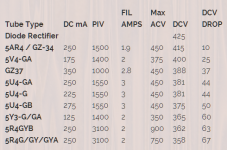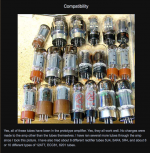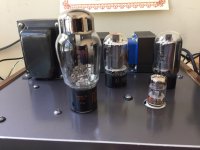Greetings- I recently bought a Tubelab SSE from a DIY Audio member. It arrived in good shape and it's been on everyday for eight hours minimum.
Today I measured the the B+ voltage (at R4 near the end of the board). It measured 473.4 Vdc.
Cathode voltage of each power tube measured between ground and the end of R17 and R27 respectively +38.3 Vdc and 38.1 Vdc.
Cathode resistors = 680 ohms, so the cathode current is ~ 56 mA per output tube.
473.4 Vdc - 38.3 Vdc = 435.1 Vdc
435.1 Vdc X 0.056 A = ~24 Watts dissipated per output tube. I haven't noticed any red plating or bright spots in the tubes.
Is this too high a B+ voltage? Would it be better to run a different rectifier tube? I have 5U4, 5R4 and know that the power transformer 5V section is rated for 3 A.
Thanks!
Today I measured the the B+ voltage (at R4 near the end of the board). It measured 473.4 Vdc.
Cathode voltage of each power tube measured between ground and the end of R17 and R27 respectively +38.3 Vdc and 38.1 Vdc.
Cathode resistors = 680 ohms, so the cathode current is ~ 56 mA per output tube.
473.4 Vdc - 38.3 Vdc = 435.1 Vdc
435.1 Vdc X 0.056 A = ~24 Watts dissipated per output tube. I haven't noticed any red plating or bright spots in the tubes.
Is this too high a B+ voltage? Would it be better to run a different rectifier tube? I have 5U4, 5R4 and know that the power transformer 5V section is rated for 3 A.
Thanks!
Last edited:
If it's the one I think it is you have 6l6's in it .The max plate dispensation for that tube is 30 watts and the max. voltage is 500 volts.Your fine all around.
Last edited:
I've got some 5881's and metal 6L6 output tubes I want to use. Any problem using these in the amp with the B+? What tube data do I look at to determine if it's safe to switch output tubes, max plate voltage? Anything else?
I would also like to try different rectifier tubes. The power transformer 5V tap is rated for 3 Amps.
I might go on a Tubelab mission and just switch them out, watch for red plating in a dark room, make sure the power transformer doesn't heat up, crash and burn, keep the fire extinguishers handy...
I would also like to try different rectifier tubes. The power transformer 5V tap is rated for 3 Amps.
I might go on a Tubelab mission and just switch them out, watch for red plating in a dark room, make sure the power transformer doesn't heat up, crash and burn, keep the fire extinguishers handy...
Your metal 6l6's are rated for 360 volts and 19 watt dissipation,and your 5881's are rated for 400 volts and 23 watt dissipation.Neither would last too long in that amp.
Also be aware that it's not uncommon that when a tube goes it sometimes takes out other parts of the amp with it.Unless you can fix it yourself you'll be stuck taking it to a tech who will gladly charge you more than what you paid for the amp to fix it.
Food for thought.
Also be aware that it's not uncommon that when a tube goes it sometimes takes out other parts of the amp with it.Unless you can fix it yourself you'll be stuck taking it to a tech who will gladly charge you more than what you paid for the amp to fix it.
Food for thought.
Last edited:
Thanks for your reply, but I'm really confused.
The tubes that came with the amp are "6N3C/0686." These are supposed to be 6L6/5881 equivalent?
On the Tubelab website, the SSE amp is supposed to work with several different output tubes, including different rectifier tubes, such as 5U4, 5R4, etc. As long as the transformer 5V tap is rated at 3 Amps. The amp has a Allied 6K7VG.
Now I'm learning there are only certain tubes that I can use.
So, my choice is to burn some tubes or look at the data sheets for max voltage? If it's 475 or below, then no can do in this amp without a different transformer and cathode resistor??
Any help is appreciated.
The tubes that came with the amp are "6N3C/0686." These are supposed to be 6L6/5881 equivalent?
On the Tubelab website, the SSE amp is supposed to work with several different output tubes, including different rectifier tubes, such as 5U4, 5R4, etc. As long as the transformer 5V tap is rated at 3 Amps. The amp has a Allied 6K7VG.
Now I'm learning there are only certain tubes that I can use.
So, my choice is to burn some tubes or look at the data sheets for max voltage? If it's 475 or below, then no can do in this amp without a different transformer and cathode resistor??
Any help is appreciated.
Attachments
Last edited:
That transformer has enough filament current for any tube in that pic.Your limiting factor as far as tube choices will be the voltage and dissipation specs of the tubes.
The 6l6gc you have in there is ok(Its a Russian version).You would be good with 6550's ,EL34's (though the plate specs is 25 watts so it would be close,but then again it might bias up at less than 25 watt dissipation.).
The Russian version of the 5881 tube is the 6n3c-E.I've used these tubes with 450 volts and biased to 25 watt dissipation for years .Really a tough tube and pretty cheap through the auction site.
Also remember these various tube will all bias differently so you would have to check them in circuit.The two tubes you wanted to try just happened to be the weakest spec wise.
Here's a list of rectifier voltage drops .Might give you a good bit of leeway.(Click to enlarge)
The 6l6gc you have in there is ok(Its a Russian version).You would be good with 6550's ,EL34's (though the plate specs is 25 watts so it would be close,but then again it might bias up at less than 25 watt dissipation.).
The Russian version of the 5881 tube is the 6n3c-E.I've used these tubes with 450 volts and biased to 25 watt dissipation for years .Really a tough tube and pretty cheap through the auction site.
Also remember these various tube will all bias differently so you would have to check them in circuit.The two tubes you wanted to try just happened to be the weakest spec wise.
Here's a list of rectifier voltage drops .Might give you a good bit of leeway.(Click to enlarge)

Brik- thank you for your reply.
Suppose I wanted to install a 5U4 rectifier tube using the Russian output tubes. I would need to watch for red plating and power transformer overheating, correct?
Suppose I wanted to install a 5U4 rectifier tube using the Russian output tubes. I would need to watch for red plating and power transformer overheating, correct?
If you go from a gz34 to a 5U4 you should drop about 20 to 25 volts(drops more as the current through the rectifier increases) which should make the tube bias lower also.It should make the output tubes run cooler.A good thing.
That transformer is rated 3 amps on the filament to the rectifier so it shouldn't be a problem with overheating at all.
That transformer is rated 3 amps on the filament to the rectifier so it shouldn't be a problem with overheating at all.
Last edited:
Last question for awhile if you have time- posting #6, the limiting factor with tube choices is the B+ voltage (anode)?
Dissipation is usually clearly stated on the data sheets.
Thank you.
Dissipation is usually clearly stated on the data sheets.
Thank you.
Yes as far as the B+ being the limiting factor if the dissipation limit is adhered to.Last question for awhile if you have time- posting #6, the limiting factor with tube choices is the B+ voltage (anode)?
Dissipation is usually clearly stated on the data sheets.
Thank you.
With the 5U4 tube you should be about 400 volts across the tube (B+ to Cathode).I'd really only discount the metal 6l6 tube at this point.The 5881's you have are good with 400 volts or so as long as they dont bias too hot.(more than 25 watts).
Just realize the 5U4 doesn't have the slow warm up capabilities the GZ34 has.It goes to full voltage almost immediately .
Good luck with it,you seem to have a good grasp on figuring things out with it!
Happy to help ,anytime.
That's how you learn.
Just try to keep the dissipation to about 70 to 80 percent of max when all is said and done.The tubes won't last too long at max ratings.
Enjoy the amp.It really is a great design.
That's how you learn.
Just try to keep the dissipation to about 70 to 80 percent of max when all is said and done.The tubes won't last too long at max ratings.
Enjoy the amp.It really is a great design.
Last edited:
On the Tubelab website, the SSE amp is supposed to work with several different output tubes.......Now I'm learning there are only certain tubes that I can use.
This was explained before we even knew that you were discussing the SSE.
Are 6L6 Metal tubes plug and play
The basic design and the PC board can indeed use every tube shown in the picture. All of those tubes DO have different specs, and are NOT directly interchangeable.
The 6K7VG power transformer is about the largest size intended for use in the SSE. It can produce from 400 to 465 volts of B+ voltage. You can not blindly stick a tube that is rated for 315 volts max (the 6V6 types) or 360 volts max (the older 6L6's) into an amp that will feed them over 400 volts. They will have short unhappy lives and possibly take out some other parts when they die. The 6K7VG sized transformer is the most popular choice, since up to 15 watts can be had in UL with KT88's or 6550's.
The amp you have was set up for good quality 6L6GC's and EL34's and most any KT88 or 6550. Do not stick metal 6L6's into this amp, I know from experience that they will overheat, but you can't see through the metal to recognize the signs. There are many tubes sold as "6L6GC's", some are good, some are not. If any tube that you put into the amp shows a red or orange glow on the outer metal element (plate) inside, discontinue it's use. An orange glow in the center element (heater / cathode) is normal.
Some builders have set up their SSE's with smaller power transformers, specifically for the lower voltage tubes. They get less power, but often chose this option with really efficient speakers that do not need more than a watt or two. I have an SSE set up for 6V6GT's that uses the 6K56VG transformer and get only 320 volts of B+ voltage. It can use any of the tubes shown in that picture, but only makes 2 to 3 watts per channel.
Thanks all for the info and advice!
I was about to go on a Dukelabs mission and risk burning up some tubes. It would have been a shorter mission than Tubelab, but I was prepared to boldly go where no tube has gone before.
Now I understand more about what to look for on the tube data sheets, as I wondered where you guys were getting the info you so graciously provide and your patience with non-EE types like me. (But I know how to spell EE. I'm an ME and know how to spell it).
Part of this adventure is because I have several students interested in building tube amplifiers. We will soon be ordering some Tubelab boards. Main reason we are going to use the Tubelab boards is because the support and there are so many people who have built them.
Thank you!
I was about to go on a Dukelabs mission and risk burning up some tubes. It would have been a shorter mission than Tubelab, but I was prepared to boldly go where no tube has gone before.
Now I understand more about what to look for on the tube data sheets, as I wondered where you guys were getting the info you so graciously provide and your patience with non-EE types like me. (But I know how to spell EE. I'm an ME and know how to spell it).
Part of this adventure is because I have several students interested in building tube amplifiers. We will soon be ordering some Tubelab boards. Main reason we are going to use the Tubelab boards is because the support and there are so many people who have built them.
Thank you!
Don't sweat it, Duke. I'm a CE, one who "eats mud pies, so you don't have to". As such, I've managed to raise stupidity to a high art on this forum. Part of that may have to do with my previous avocation as a Surveyor (to which I refer as "the world's 2nd oldest profession" - just ask any pyramid). We used to half-joke that in order to become one, you have to forget how to spell... 😛
Counting, however, is another matter altogether.
Counting, however, is another matter altogether.
Last edited:
My university days and my youth... long gone. But, I remember the nerdy engineers with t-squares and calculators being standard equipment and a tee shirt that said: Yesterday I couldn't spell engineer and today I are one.
I've always wondered if somebody made an Excel spreadsheet/website with tube data, at least for the popular/common tubes? Something like a website with steam tables like this:
Steam Tables Calculator
If a non-engineer/technician looks at tube data sheets, there are values given for max plate voltage. The plate is also called the anode. Max dissipation is listed for triode connected class A, UL connected, etc., and UL isn't Underwriters Laboratory. Maybe it's because tubes aren't being manufactured in the quantities they once were, but there are still a lot of people who like tube amplifiers.
Those are some of the things that confuse me, and I thank the people on this forum for providing the guidance and information!
I've always wondered if somebody made an Excel spreadsheet/website with tube data, at least for the popular/common tubes? Something like a website with steam tables like this:
Steam Tables Calculator
If a non-engineer/technician looks at tube data sheets, there are values given for max plate voltage. The plate is also called the anode. Max dissipation is listed for triode connected class A, UL connected, etc., and UL isn't Underwriters Laboratory. Maybe it's because tubes aren't being manufactured in the quantities they once were, but there are still a lot of people who like tube amplifiers.
Those are some of the things that confuse me, and I thank the people on this forum for providing the guidance and information!
Have you been here? Also on the same site is PSUDII, a freeware power supply simulator you can download. Well worth a look.I've always wondered if somebody made an Excel spreadsheet/website with tube data, at least for the popular/common tubes? Something like a website with steam tables...
- Status
- Not open for further replies.
- Home
- More Vendors...
- Tubelab
- New Tubelab SSE for me

